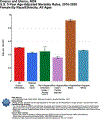Disparities in Gynecologic Cancers
- PMID: 37963369
- PMCID: PMC11781792
- DOI: 10.1097/PPO.0000000000000678
Disparities in Gynecologic Cancers
Abstract
Gynecologic cancer disparities have different trends by cancer type and by sociodemographic/economic factors. We highlight disparities in the United States arising due to poor delivery of cancer care across the continuum from primary prevention, detection, and diagnosis through treatment and identify opportunities to eliminate/reduce disparities to achieve cancer health equity. Our review documents the persistent racial and ethnic disparities in cervical, ovarian, and uterine cancer outcomes, with Black patients experiencing the worst outcomes, and notes literature investigating social determinants of health, particularly access to care. Although timely delivery of screening and diagnostic evaluation is of paramount importance for cervical cancer, efforts for ovarian and uterine cancer need to focus on timely recognition of symptoms, diagnostic evaluation, and delivery of guideline-concordant cancer treatment, including tumor biomarker and somatic/germline genetic testing.
Copyright © 2023 Wolters Kluwer Health, Inc. All rights reserved.
Conflict of interest statement
Conflicts of Interest and Source of Funding: K.O. is co-founder of Tactiva Therapeutics. N.K.L. is an educational consultant for the National Ovarian Cancer Coalition. J.A.T. has no significant relationships with, or financial interest in commercial companies pertaining to this article. K.O., J.A.T., and N.K.L. are supported by NCI grant P30CA014599. J.A.T. also receives research support from NCI grants UM1CA221940 and R01CA240375.
Figures







References
-
- Mix JM, Van Dyne EA, Saraiya M, Hallowell BD, Thomas CC. Assessing Impact of HPV Vaccination on Cervical Cancer Incidence among Women Aged 15–29 Years in the United States, 1999–2017: An Ecologic Study. Cancer Epidemiol Biomarkers Prev 2021;30(1):30–37. (In eng). DOI: 10.1158/1055-9965.Epi-20-0846. - DOI - PMC - PubMed

